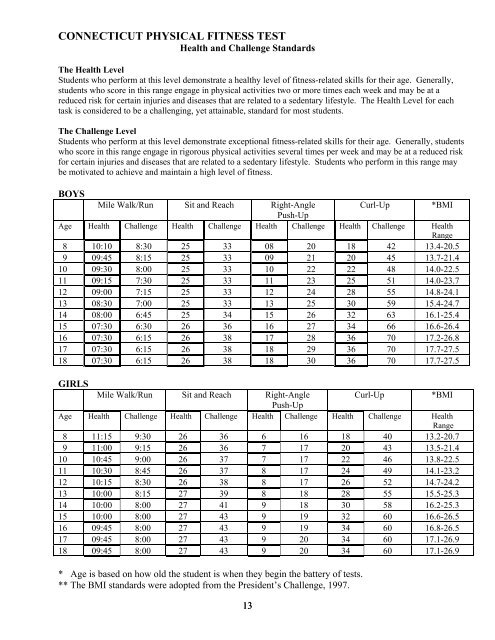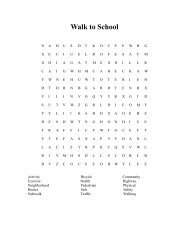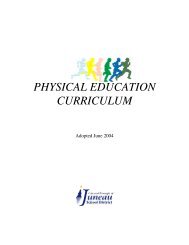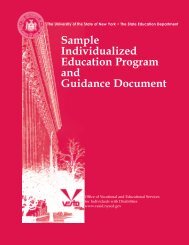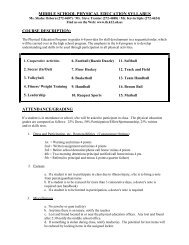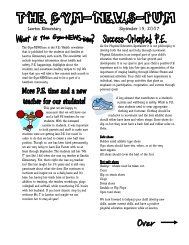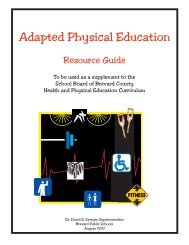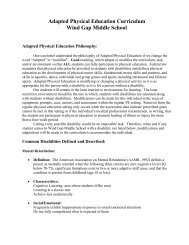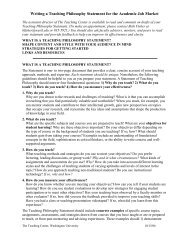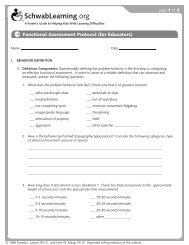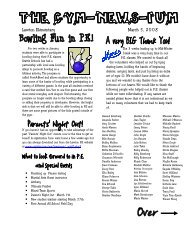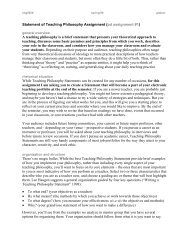CONNECTICUT PHYSICAL FITNESS TEST - thenewPE
CONNECTICUT PHYSICAL FITNESS TEST - thenewPE
CONNECTICUT PHYSICAL FITNESS TEST - thenewPE
- No tags were found...
Create successful ePaper yourself
Turn your PDF publications into a flip-book with our unique Google optimized e-Paper software.
Class Record Form – GirlsGrade ___________ Date__________ Class_______________ Test Administrator______________________________Student NameAgeWhen testing began✔ If MedicalExemptionFlexibilityModifiedSit andReach(cm)RL✔ If Met HealthStandardMuscularStrength/EndurancePartial Curlups(#completed)✔ If Met HealthStandardUpper-BodyStrengthPush-ups(#completed)✔ If Met HealthStandardAerobicEnduranceOne-MileRun(min/sec)123456789101112131415161718192021Highlight those students tested on ALL 4 items then fill in the totals below including ONLY those students tested on ALL 4 items.Totals:Number of students tested on ALL 4items ➜** Students who were not tested on all four tests should not be counted in the “Totals” for meeting Health Standards.***If a student refuses to do a test item (is not medically exempt) they score a “0” and are counted.15✔ If Met HealthStandard✔ForStudentsMeetingthe HealthStandardon All 4Test Items
Connecticut Physical Fitness AssessmentTest Administrator’s Summary Report FormSchool_______________________________ School District _______________ Date_____________Test Administrator_____________________Principal ____________________Fitness assessment information will be reported on the Strategic School Profile. For test administrators teachingin more than one school, the information must be reported separately for each school. Information needed forthis form can be found on the Class Record Forms.One copy of this Summary Report Form should be submitted to the school principal for inclusion on theED165 report to the State Department of Education. Test Administrators should retain one copy of allforms for their own records. The Health Standards should always be used for reporting.TOTALS – Taken from the bottom line of the ClassRecord FormsGrade Four Grade Six Grade Eight Grade TenBoys Girls Boys Girl Boys Girls Boys GirlsA. Number of Students Tested on all 4 ItemsB. Number of Students Medically ExemptC. Number of Students Meeting the FlexibilityStandard (Modified Sit and Reach Test)D. Number of Students Meeting the Strength andEndurance Standard (Partial Curl-Up Test)E. Number of Students Meeting the Upper BodyStrength Standard (Right-Angle Push-Up Test)F. Number of Students Meeting the AerobicStandard (One-Mile Run/Walk)G. Number of Students Meeting the Standards on4 Test Items* The number of students meeting a standard on any one test should never exceed the numbertested on all 4 items.** Students who were not tested on all 4 items should not be counted in the totals reported on theseforms.*** Students who refuse to do a test item and are not medically exempt, score a “0”, and should becounted in the totals.16
I. Student InformationConnecticut Physical Fitness AssessmentIndividual Student ReportName: _____________________________________ Gender: Male _____Last First Female _____Grade: _________Age: _______________School: ____________________________________District: _________________Height: Weight: Body Mass Index: ______________✔ If standard was met: _________II.Test Performance ObjectivesStudentScoreHealthStandard *✔ IfStandardMetChallengeStandard*✔ IfStandardMetFlexibilityRModified Sit and Reach Test# ofLcentimeters reachedMuscular Strength/EndurancePartial Curl-Up Test# of curl-ups completedUpper Body StrengthRight-Angle Push-Up Test# of push-ups completedAerobic EnduranceOne-mile run/walkTime in minutes/seconds The Fitness Standards were established specifically for Connecticut through a formal standards-settingprocess. This involved professionals from the physical education field in Connecticut and used national andstate data.The Health Level: Students who perform at this level demonstrate a healthy level of fitness-related skills fortheir age. Generally, students who score in this range engage in physical activities two or more times eachweek and may be at a reduced risk for certain injuries and diseases that are related to a sedentary lifestyle. TheHealth Level for each task is considered to be a challenging, yet attainable, standard for most students.The Challenge Level: Students who perform at this level demonstrate exceptional fitness-related skills fortheir age. Generally, students who score in this range engage in rigorous physical activities several times perweek and may be at a reduced risk for certain injuries and diseases that are related to a sedentary lifestyle.Students who perform in this range are motivated to achieve and maintain a high level of fitness.17
Connecticut Physical Fitness CommitteeAppendix ADavid Camaione, Chairperson, University of ConnecticutTom Bockett, Unified School District 2Connie Kapral, Glastonbury Public SchoolsDave Harackewiecz, Central Connecticut State UniversityGeorge Taylor, Regional School District 5Denise Swan, Naugatuck Public SchoolsState Department of Education RepresentativesBarb WestwaterPeter ProwdaRaymond MartinAppendix BFitness Testing - Children Who Are Physically Challenged“No otherwise qualified handicapped individual in the United States… Shall, solely by reason of his handicap,be excluded from participation in, be denied the benefits of, or be subjected to discrimination under anyprogram or activity which receives benefits from Federal financial assistance.” Sec. 504In administering the Connecticut Physical Fitness Assessment, students with disabilities should be included.Fitness activities, exercises and testing should be part of the physical education curriculum and offered to allstudents. Historically, fitness tests were designed only for nondisabled persons. The test included in thismanual, though designed for nondisabled students, can be personalized to include all. Due to the fact thatemphasis is placed on a personalized approach and the reality that physical fitness profiles, components and testitems for disabled students require modification from those typically used, the many possibilities are notincluded in this document. Resources are available to assist physical educators with both the testing andstandards that are appropriate for assessing the physical fitness of students with disabilities.A child who is tested using an alternate method or with adjusted standards should not be included in thetotals on the Summary Data Report. If a child with a disability meets standards that are appropriate forthem, they should be recognized along with other children who meet the Health Standards.There are many resources available regarding levels of performance and the use of fitness assessments forstudents with disabilities. Some of these are included in the resource section beginning on page 2318
The Components ofPhysical FitnessThe Connecticut Physical Fitness Assessmentis given annually to all students in grades 4, 6,8, and 10. It consists of the five componentsof fitness. This pamphlet is to inform parentsand guardians about the importance ofphysical fitness.FlexibilityTest: Modified Sit and ReachObjective and Rationale: The objective of this testis to reach a specified distance on the right andleft sides. It measures flexibility of the lower backand hamstrings. Proper hamstring flexibilityhelps avoid lower back pain.Tips:➜ The modified sit and reach is a good exercise aswell as a test.➜ Remember that general stretching of majormuscle groups to develop flexibility involves aslow and controlled motion. Hold a stretchfor 10 to 30 seconds.➜ Hold the body or limbs in a position thatelongates the muscles to a point where youfeel stretching – not pain.Abdominal Strength andEnduranceTest: Partial Curl-upObjective and Rationale: The objective of this testis to complete as many partial curl-ups as possibleat a rhythmic pace. Abdominal fitness isimportant to good health because low levels areassociated with bad posture and lower back pain.Tips:➜ The partial curl-up is a good exercise as wellas a test. Learning to pace oneself andcontrolling the movement by engaging themuscles is essential.Upper Body Strength andEnduranceCardiorespiratory FitnessTest: One-Mile Run/WalkObjective and Rationale: The objective of the testis to measure cardiorespiratory or aerobicendurance. The one-mile run/walk is a goodindicator of the ability of the circulatory andrespiratory systems to supply oxygen tofunctioning muscles.Tips:➜ Accumulate at least 30 min. of moderateto vigorous physical activity daily.➜ Practice pacing – not racing.➜ Participate in activities which featureconstant movement for an extended period oftime. The following are some examples ofaerobic exercises which increase your heartrate:walk briskly rope jumpinghikingjoggingdancing bicyclingTest: Right Angle Push-up cross country skiing swimmingObjective and Rationale: The objective of this testis to complete as many right angle push-ups aspossible at a rhythmic pace. Upper body musclefitness is required in order to perform daily livingand recreational activities with vigor and unduefatigue.Tips:➜ The right angle push-up is a good exercise aswell as a test.➜ The following activities are some ways toincrease upper body strength:Pull-upsHorizontal ladderPush-up position-raise hand to wave-switch handsPush-up position- walk on hands and feetAge appropriate resistance trainingBody CompositionTest: Body Mass IndexObjective and Rationale: The body massindex (BMI) provides an indication of theappropriateness of a person’s weight relative toheight. High BMI scores have been significantlycorrelated with cardiovascular disease in adults.Tips:➜ Maintain a physically active lifestyle➜ Practice good nutritional habits➜ Like yourself. People come in all types ofshapes and sizes. Try to do what is best foryour body.20
Appendix DEquipmentConstructing the Sit and Reach Box23 cm. mark21”12”12”1. Using any sturdy wood or comparable construction material (3/4-inch plywood or comparable constructionmaterial is recommended), cut the following pieces:2 pieces 12in. X 12 in.2 pieces 12 in. X 10 in.1 piece 12 in. X 21 in.2. Assemble the pieces using nails or screws, and wood glue.3. Inscribe one-centimeter gradations on the top panel. It is crucial that the 23 centimeter line be exactly inline with the vertical plane against which the subject’s feet will be placed.4. Cover the apparatus with two coats of polyurethane sealer or shellac.5. For convenience, a handle can be made by cutting a 1 x 3 inch hole in the top panel.6. The measuring scale should extend from about 9 cm. to 50 cm.Developing the Audio PacerThe curl-ups and push-ups are performed to a cadence of one complete repetition every three seconds. This isbest accomplished through an audiotape recording. The simplest way to do this is to record a metronome set at40 beats per minute. Each click of the metronome represents the up or down phase of a curl-up or push up, (1.5seconds up and 1.5 seconds down). In other words, two clicks represent one complete repetition.At the beginning of the audiotape some dialogue may be included. Example: For the curl-ups; “Students takeyour positions, this test will begin in five seconds…, three, two, one, up, down” The use of verbal cues,“up/down”, can be helpful and included, as long as the cadence is the same. Prepare your tape well ahead oftime and practice using it with your students. This will help the students to become comfortable with the pacingand scores will be more reliable.21
Using a Right-Angle MarkerThe use of a carpenter’s right angle, a T-square, or simply two pieces of wood fastened together at a right angleis suggested. This device, placed upright in front of each student being tested, provides a good visual aid for thetest administrator and the student. Ideally, if something can be created that slides up and down, this wouldallow adjustment for individual size differences.Suggested Layouts for the One-Mile Run/WalkThe one-mile run/walk can be performed on any flat surface that measures one mile in distance. The course canbe laid out in any shape which uses the area as efficiently as possible, maximizes straightaway running andminimizes corners or turns. It may be necessary to lay out a course around the perimeter of the school propertyor around the school building. Use of a measuring wheel or tape will provide accuracy. Pacing out anestimated mile is not acceptable. There are 5,280 feet or 1,760 yards in one mile.1. A 440-yard track will require four laps to complete one mile.2. An area marked off with 55 yards on all four sides will require eight laps to complete the mile.One lap would equal 220 yards (55 x 4). Eight laps would equal 1,760 yards (220 x 8).3. An area marked off with 27.5 yards on all four sides will require 16 laps to complete the mile. One lapwould equal 110 yards (27.5 X 4). Sixteen laps would equal 1,760 yards (110 X 16).22
ResourcesPhysical FitnessAmerican Alliance for Health, Physical Education, Recreation and Dance. Physical Best Activity Guide –Elementary Level. Reston, VA: AAHPERD, 1999.American Alliance for Health, Physical Education, Recreation and Dance. Physical Best Activity Guide –Secondary Level. Reston, VA, AAHPERD, 1999.Collingwood, Thomas R. Helping At-Risk Youth Through Physical Fitness Programming. Champaign, IL:Human Kinetics, 1997.Harris, Jo and Elbourn, Jill. Teaching Health-Related Exercise at Key Stages 1 and 2. Champaign, IL: HumanKinetics, 1997.Hopper, Chris; Fisher, Bruce and Munoz, Kathy D. Health-Related Fitness for Grades 1 and 2, 3 and 4, 5 and6. Champaign, IL: Human Kinetics, 1997.Pangrazi, Robert P. and Corbin, Charles B., Teaching Strategies for Improving Youth Fitness. Reston, VA:AAHPERD, 1994.Virgilio, Stephen J. Fitness Education for Children A Team Approach. Champaign, IL: Human Kinetics, 1997.Physical Fitness – Children With DisabilitiesMiller, Patricia D. Fitness Programming and Physical Disability. Champaign, IL: Human Kinetics, 1995.Seaman, Janet A. Physical Best and Individuals With Disabilities: A Handbook for Inclusion in FitnessPrograms. Reston, VA: AAHPERD, 1995.Winnick, Joseph, P. and Short, Francis X. The Brockport Physical Fitness Test Manual,The National Health-Related Test for Youths with Physical and Mental Disabilities. Champaign, IL: Human Kinetics, 1999.Physical Activity – WellnessJackson, Allen W.; Morrow Jr., James R.; Hill, David W.; and Dishman, Rod K. Physical Activity for Healthand Fitness. Champaign, IL: Human Kinetics, 1999.Sharkey, Brian J. Fitness and Health. Champaign, IL: Human Kinetics, 1997.U.S. Department of Health and Human Services Centers for Disease Control and Prevention, National Centerfor Chronic Disease Prevention and Health Promotion, Division of Nutrition and Physical Activity.Promoting Physical Activity: A Guide for Community Action. Champaign, IL: Human Kinetics, 1999.23
OrganizationsAmerican Alliance for Health, Physical Education, Recreation and Dancewww.aahperd.orgConnecticut Association for Health, Physical Education, Recreation and Dancewww.ctahperd.orgNational Association of Governor’s Councils on Physical Fitness and Sportswww.physicalfitness.orgThe President’s Challenge Youth Physical Fitness Programwww.indiana.edu/~preschal/24


